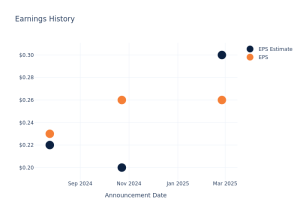
Nvidia (NASDAQ: NVDA) has been one of the hottest artificial intelligence (AI) stocks on the market. Its split-adjusted share price has increased nearly 700% since 2023. But the stock has actually slipped 14% since peaking around $136 per share in June, shortly after the company completed its 10-for-1 stock split.
One reason for the backslide is uncertainty surrounding the sustainability of AI spending. Investors want proof that capital expenditures are boosting revenue growth and productivity. But scant supporting evidence has led to concerns about AI budget cuts.
Another reason for the backslide is the sequential decline in Nvidia’s gross margin in the recent quarter, a potential sign of competitive pressure. Several companies are designing custom AI chips, and investors are worried that Nvidia could lose its market dominance.
However, Wall Street has good news for Nvidia shareholders on both fronts. Here are the important details.
JPMorgan says investments in AI infrastructure are building momentum
Jonathan Linden and Joe Seydl at JPMorgan believe capital expenditures related to artificial intelligence (AI) infrastructure are still building momentum. They estimate spending from five hyperscale cloud companies — Microsoft, Amazon, Alphabet, Meta Platforms, and Oracle — will increase at 24% annually over the next five years, up from 15% annually over the last five.
Additionally, Linden and Seydl expect AI to have a measurable impact on productivity by the end of the decade. That may sound like the distant future, but they explained that the interval between technological innovation and productivity gains is actually shrinking. “Think of it this way: It took 15 years for the personal computer to increase the economy’s productivity. AI could do it in seven.”
The International Data Corp. forecasts artificial intelligence will add $4.9 trillion to the global economy in 2030, up from $1.2 trillion this year. In that scenario, AI would account for 3.5% of global GDP when the decade ends. The implications of that estimate are enormous: Investments in AI are not only worthwhile, but also critical for businesses that hope to keep up with their competitors.
Naysayers will undoubtedly write AI off as an overhyped technology in the coming years, just as some people did with the internet in the 1990s. And AI stocks may suffer a massive drawdown at some point, just as internet stocks did in the early 2000s. But the naysayers will ultimately be proven wrong, and Nvidia’s share price could climb much higher in the future. Indeed, Beth Kindig at the I/O Fund believes Nvidia could be a $10 trillion company by 2030.
Morgan Stanley says Nvidia’s competitors consistently come up short
Nvidia builds the most covered graphics processing units (GPUs) in the computing industry. The company accounted for 98% of data center GPU shipments last year, and those processors are the gold standard in accelerating AI workloads. Nvidia’s market share in AI chips exceeds 80%, and Forrester Research recently wrote, “Without Nvidia GPUs, modern AI wouldn’t be possible.”
The tidal wave of demand for AI infrastructure has naturally drawn more competitors to the market. That includes chipmakers like Intel and Advanced Micro Devices, as well as big tech companies like Alphabet, Amazon, and Apple. All of them have designed alternative GPUs or custom AI accelerators. But CEO Jensen Huang is confident that Nvidia chips offer the “lowest total cost of ownership,” meaning chips with cheaper price points may actually cost more once associated expenses are included.
Even so, Nvidia will almost certainly lose some market share as custom AI accelerators become increasingly popular in the years ahead. But losing some market share is not the same as losing its market leadership. Nvidia’s superior hardware, coupled with its robust ecosystem of supporting software for developers, give the company a deep competitive moat that rivals find it difficult to overcome.
Analysts at Morgan Stanley said as much in a recent note. “We have seen many threats to Nvidia come and go since 2018 — something like a dozen start-ups, several efforts from merchant competitors such as Intel and AMD, and several custom designs. Most of those have come up short. Competing with Nvidia, a company that spends $10 billion per year in R&D, is a difficult feat.”
Wall Street expects Nvidia’s earnings to grow rapidly
Wall Street is very bullish on Nvidia. Of the 64 analysts following the company, 94% rate the stock a buy and the remaining 6% rate the stock a hold. Not a single analyst recommends selling the stock right now. And Nvidia has a median price target of $150 per share, which implies 29% upside from its current share price of $116, according to CNN Business.
Going forward, Wall Street analysts expect Nvidia’s earnings to increase at 36% annually over the next three years. That consensus estimate makes the current valuation of 54 times earnings look quite reasonable. Those figures give a PEG ratio of 1.5, a substantial discount to the three-year average of 3.1. That’s good news for prospective investors.
Should you invest $1,000 in Nvidia right now?
Before you buy stock in Nvidia, consider this:
The Motley Fool Stock Advisor analyst team just identified what they believe are the 10 best stocks for investors to buy now… and Nvidia wasn’t one of them. The 10 stocks that made the cut could produce monster returns in the coming years.
Consider when Nvidia made this list on April 15, 2005… if you invested $1,000 at the time of our recommendation, you’d have $710,860!*
Stock Advisor provides investors with an easy-to-follow blueprint for success, including guidance on building a portfolio, regular updates from analysts, and two new stock picks each month. The Stock Advisor service has more than quadrupled the return of S&P 500 since 2002*.
*Stock Advisor returns as of September 23, 2024
John Mackey, former CEO of Whole Foods Market, an Amazon subsidiary, is a member of The Motley Fool’s board of directors. Suzanne Frey, an executive at Alphabet, is a member of The Motley Fool’s board of directors. JPMorgan Chase is an advertising partner of The Ascent, a Motley Fool company. Randi Zuckerberg, a former director of market development and spokeswoman for Facebook and sister to Meta Platforms CEO Mark Zuckerberg, is a member of The Motley Fool’s board of directors. Trevor Jennewine has positions in Amazon and Nvidia. The Motley Fool has positions in and recommends Advanced Micro Devices, Alphabet, Amazon, Apple, JPMorgan Chase, Meta Platforms, Microsoft, Nvidia, and Oracle. The Motley Fool recommends Intel and recommends the following options: long January 2026 $395 calls on Microsoft, short January 2026 $405 calls on Microsoft, and short November 2024 $24 calls on Intel. The Motley Fool has a disclosure policy.
Nvidia Stock Investors Just Got Good News From Wall Street: The Artificial Intelligence (AI) Boom Is Thriving was originally published by The Motley Fool

